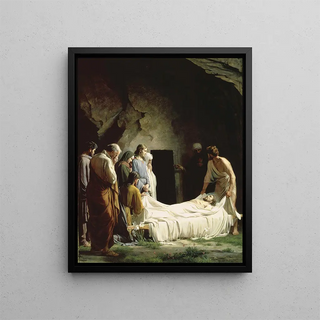Art print | The Entombment - Carl Bloch


View from behind

Frame (optional)
La mise au tombeau of Carl Bloch is a work that transcends the simple framework of religious painting to offer a spiritual and emotional experience of rare depth. By depicting the poignant moment of Christ's burial, the Danish artist manages to capture not only the sadness of the scene but also a light of hope and redemption. The composition, rich in detail and emotion, invites us to contemplate the mystery of death and the promise of eternal life. This painting, a true masterpiece of the 19th century, serves as an entry point for reflection on faith, loss, and human resilience.
Style and uniqueness of the work
Carl Bloch's style is characterized by an exceptional mastery of chiaroscuro, where light plays a central role in visual storytelling. In The Burial, he uses striking contrasts to highlight the main figures, while the background blends into a suggestive shadow, creating an atmosphere that is both intimate and solemn. The expressions of the characters are beautifully rendered, each face telling a story of pain, loss, and love. The drapery of the clothing, carefully painted, adds a tactile dimension to the scene, enhancing the impression of movement and life. Bloch succeeds in infusing a palpable humanity into his figures, making the work not only accessible but also deeply touching.
The artist and his influence
Carl Bloch, born in 1834 in Copenhagen, is one of the most emblematic artists of the Danish Romantic movement. His training in Europe, notably at the Royal Danish Academy of Fine Arts in Copenhagen, allowed him to incorporate influences from old masters while cultivating a distinctive personal style. Bloch dedicated a large part of his career to depicting biblical themes, seeking to make spirituality tangible through art. His work has influenced many contemporary and later artists, and he is often cited as a reference in the field of religious painting. The Burial, in particular, has become a flagship work that continues to inspire and move generations of viewers, testifying to the timeless power of

Matte finish

View from behind

Frame (optional)
La mise au tombeau of Carl Bloch is a work that transcends the simple framework of religious painting to offer a spiritual and emotional experience of rare depth. By depicting the poignant moment of Christ's burial, the Danish artist manages to capture not only the sadness of the scene but also a light of hope and redemption. The composition, rich in detail and emotion, invites us to contemplate the mystery of death and the promise of eternal life. This painting, a true masterpiece of the 19th century, serves as an entry point for reflection on faith, loss, and human resilience.
Style and uniqueness of the work
Carl Bloch's style is characterized by an exceptional mastery of chiaroscuro, where light plays a central role in visual storytelling. In The Burial, he uses striking contrasts to highlight the main figures, while the background blends into a suggestive shadow, creating an atmosphere that is both intimate and solemn. The expressions of the characters are beautifully rendered, each face telling a story of pain, loss, and love. The drapery of the clothing, carefully painted, adds a tactile dimension to the scene, enhancing the impression of movement and life. Bloch succeeds in infusing a palpable humanity into his figures, making the work not only accessible but also deeply touching.
The artist and his influence
Carl Bloch, born in 1834 in Copenhagen, is one of the most emblematic artists of the Danish Romantic movement. His training in Europe, notably at the Royal Danish Academy of Fine Arts in Copenhagen, allowed him to incorporate influences from old masters while cultivating a distinctive personal style. Bloch dedicated a large part of his career to depicting biblical themes, seeking to make spirituality tangible through art. His work has influenced many contemporary and later artists, and he is often cited as a reference in the field of religious painting. The Burial, in particular, has become a flagship work that continues to inspire and move generations of viewers, testifying to the timeless power of






